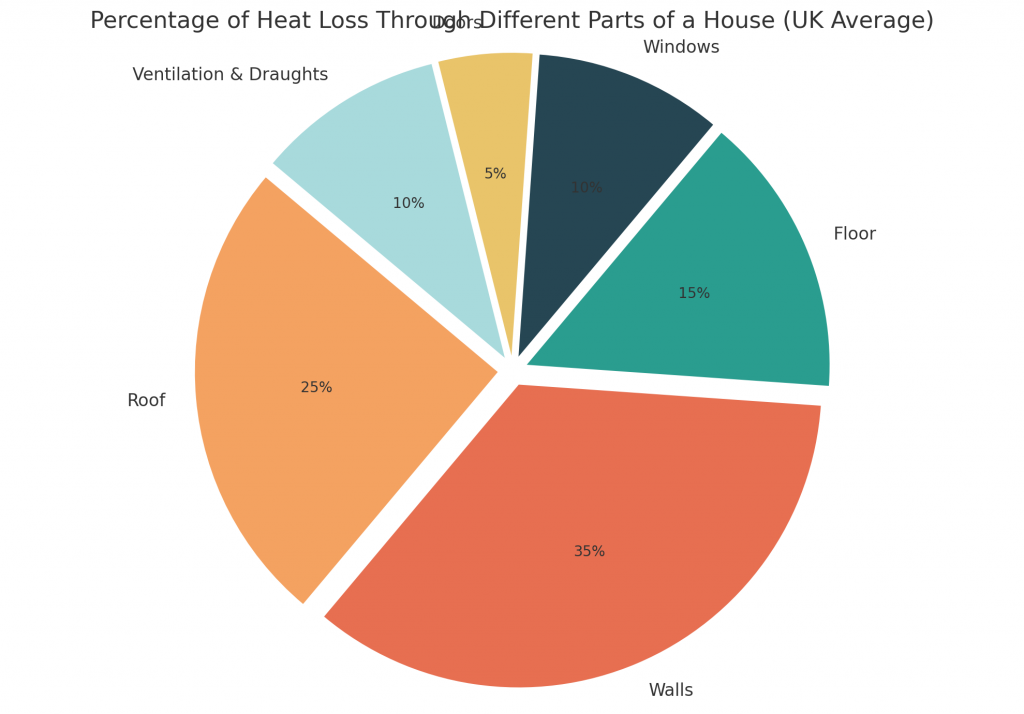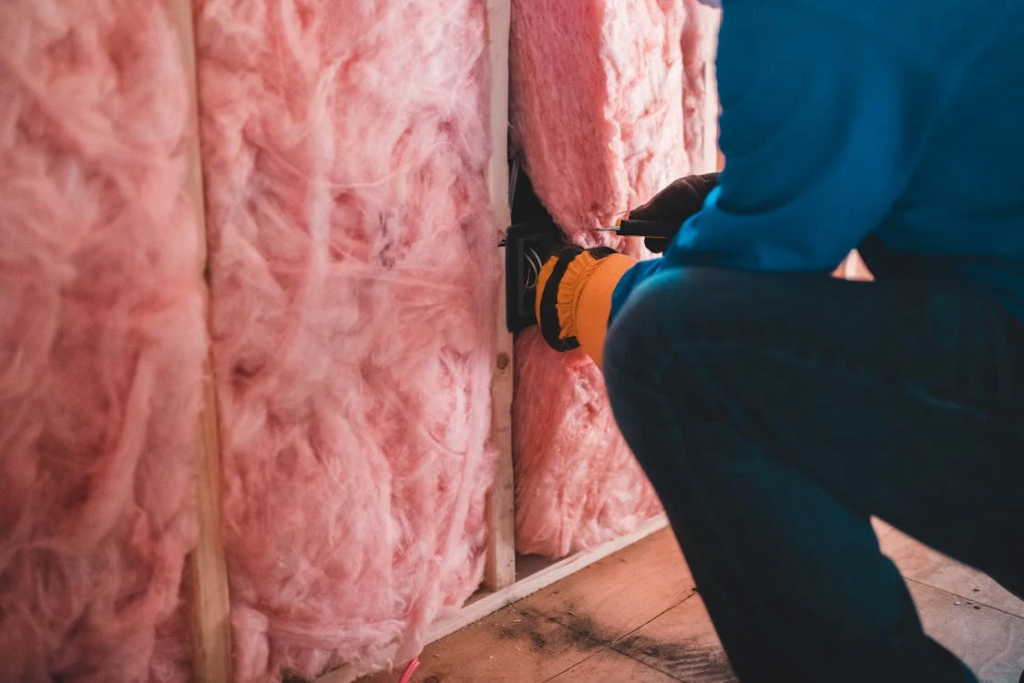Last updated: May 2025

If your home feels cold, costs a fortune to heat, or you’re simply looking to reduce your carbon footprint, insulation is the single most effective upgrade you can make. But with so many options—cavity wall, internal wall, loft insulation, and more—knowing where to start can feel overwhelming.
This comprehensive guide cuts through the confusion, showing you exactly which insulation upgrades to prioritise, what they cost, and how to access free funding through government schemes.
Quick Answer: Where Should You Start?
Based on decades of building science research and real-world retrofit data, here’s the optimal order for insulation upgrades:
- Loft insulation (if less than 270mm) – £300-800, saves £150-250/year
- Cavity wall insulation (if you have cavity walls) – £400-800, saves £150-300/year
- Draught-proofing – £100-300, saves £50-90/year
- Solid wall insulation (internal or external) – £2,000-15,000, saves £250-600/year
- Floor insulation – £800-2,000, saves £60-150/year
Understanding Your Home’s Heat Loss
According to the Building Research Establishment (BRE) and Energy Saving Trust, the average uninsulated UK home loses heat through:

- 35% through walls (the biggest single loss)
- 25% through the roof
- 15% through draughts
- 15% through floors
- 10% through windows
This data makes it clear: walls and roofs should be your priority. But the best starting point depends on your home’s current insulation levels and construction type.
Loft Insulation: Your First Priority
Why Start Here?
Loft insulation offers the best return on investment of any insulation upgrade. Heat rises, and without proper loft insulation, it escapes straight through your roof. Most UK homes built before 1990 have inadequate loft insulation.
Current Standards
- Recommended depth: 270mm (about 11 inches)
- If you have less than 100mm: Upgrade immediately
- If you have 100-200mm: Top up to current standards
Cost and Savings
- DIY cost: £300-500 for materials
- Professional installation: £500-800
- Annual savings: £150-250
- Payback period: 2-5 years

Types of Loft Insulation
Mineral Wool Rolls
- Most common and affordable
- Good thermal performance
- Can be installed DIY
- Needs protective equipment when handling
Sheep’s Wool
- Natural and breathable
- More expensive but eco-friendly
- Naturally regulates moisture
- No protective equipment needed
Blown Fibre
- Professional installation only
- Ideal for awkward spaces
- Quick installation
- Good for topping up existing insulation
DIY vs Professional Installation
You can install loft insulation yourself if:
- Your loft is easily accessible
- You have no damp issues
- The joists are regular and even
- You’re comfortable working in confined spaces
Hire a professional if:
- Your loft has difficult access
- You spot signs of damp or condensation
- You want blown insulation
- You’re eligible for free installation through ECO4
Note: If you’re on benefits or have a low income, you may qualify for free loft insulation through the ECO4 scheme. Our recommended provider, Blueape Renewables, can check your eligibility and arrange installation at no cost.
Wall Insulation: The Biggest Impact
First: What Type of Walls Do You Have?
Cavity Walls (homes built 1920-1990)
- Two layers of brick with a gap between
- Regular brick pattern
- Walls usually 260-280mm thick
Solid Walls (pre-1920 homes)
- Single layer of brick or stone
- Alternating brick pattern (headers and stretchers)
- Walls usually 220mm thick
Not sure? Check your Energy Performance Certificate (EPC) or measure the thickness at a door or window.
Cavity Wall Insulation
If you have unfilled cavity walls, this should be your second priority after loft insulation.

Benefits:
- Relatively inexpensive
- Quick installation (2-3 hours)
- No disruption inside your home
- Often free through ECO4
Costs and Savings:
- Professional installation: £400-800
- Annual savings: £150-300
- Payback period: 3-7 years
The Process:
- Installer drills small holes in external walls
- Insulation material is blown into the cavity
- Holes are filled and made good
- Minimal mess or disruption
Materials Used:
- Mineral wool (most common)
- Polystyrene beads
- Polyurethane foam (for difficult cavities)
Solid Wall Insulation
For older homes with solid walls, you have two main options:
Internal Wall Insulation (IWI)
Pros:
- Cheaper than external
- Can be done room by room
- No planning permission needed
- Preserves external appearance
Cons:
- Reduces room size (5-10cm per wall)
- Disruption during installation
- Need to move radiators and sockets
Cost: £2,000-4,000 (DIY) or £4,000-8,000 (professional)
External Wall Insulation (EWI)
Pros:
- No loss of internal space
- Improves external appearance
- Can fix external defects
- Better thermal performance
Cons:
- More expensive
- May need planning permission
- Weather dependent installation
- Changes home’s appearance
Cost: £8,000-15,000
Modern Insulation Materials
Phenolic Foam Boards
- Highest performance (thin but effective)
- Ideal for internal wall insulation
- More expensive but saves space
Wood Fibre Boards
- Breathable and eco-friendly
- Good moisture management
- Ideal for older properties
Aerogel Blankets
- Ultra-thin high performance
- Very expensive
- Good for difficult areas
Draught-Proofing: Quick Wins
Often overlooked, draught-proofing offers the fastest payback of any energy efficiency measure.

Where to Check
Windows
- Gaps around frames
- Between sash and frame
- Broken or missing seals
Doors
- Under external doors
- Around door frames
- Letter boxes and keyholes
Other Areas
- Loft hatches
- Floorboards and skirting
- Pipework penetrations
- Old extractor fans
DIY Solutions
- Brush strips: £5-10 per door
- Foam strips: £3-5 per window
- Silicone sealant: £5-10 per tube
- Chimney balloons: £20-30
- Keyhole covers: £5-10
Total DIY cost: £100-200 for average home Annual savings: £50-90 Payback: Often under 1 year
Professional Draught-Proofing
For comprehensive draught-proofing, including difficult areas like suspended floors, consider professional help. Cost: £300-500.
Floor Insulation: Worth Considering
While not a priority for most homes, floor insulation can improve comfort and reduce heat loss.
When to Consider Floor Insulation
- During renovations
- If you have suspended timber floors
- If floors feel particularly cold
- When installing underfloor heating
Options and Costs
Suspended Timber Floors
- Insulation between joists
- Cost: £800-1,200
- DIY possible but challenging
Solid Floors
- Only during major renovation
- Cost: £2,000-5,000
- Professional installation required
Accessing Free Insulation: ECO4 and Other Schemes
ECO4 Eligibility
You may qualify for free insulation if you:
- Receive certain benefits
- Have a household income under £31,000
- Live in social housing
- Have an EPC rating of D or below
What’s Covered
- Loft insulation
- Cavity wall insulation
- Internal wall insulation
- Sometimes: external wall insulation
How to Apply
- Check your eligibility
- Find an approved installer
- Get a survey
- Installation at no cost
Blueape Renewables is our recommended ECO4 installer. They offer quick eligibility checks, professional surveys, and handle all paperwork on your behalf.
Common Insulation Problems and Solutions
Condensation and Damp
Problem: Insulation installed without proper ventilation Solution: Ensure adequate ventilation, use breathable materials
Settling Cavity Wall Insulation
Problem: Insulation settles over time, leaving gaps Solution: Top-up installation or cavity extraction and refill
Thermal Bridging
Problem: Cold spots where insulation is interrupted Solution: Continuous insulation layer, attention to details
Planning Your Insulation Journey
Year 1: The Basics
- Install loft insulation (£300-800)
- Draught-proof your home (£100-300)
- Apply for ECO4 funding
Year 2: Major Upgrades
- Cavity wall insulation (£400-800)
- Or begin internal wall insulation
Year 3+: Complete the Envelope
- Finish wall insulation
- Consider floor insulation
- Upgrade windows if needed
Insulation and Heat Pumps
If you’re considering a heat pump, insulation is essential. Heat pumps work most efficiently in well-insulated homes. Most installers recommend:
- Minimum 270mm loft insulation
- Filled cavity walls or insulated solid walls
- Good draught-proofing
- Double glazing
Finding Quality Installers
What to Look For
- TrustMark registered
- PAS 2030 certified (for retrofit)
- Insurance for the work
- Guarantees (25 years for cavity wall)
- Local references you can check
Red Flags to Avoid
- Cold callers offering “free surveys”
- Requests for upfront payment
- Pressure to sign immediately
- No proper assessment survey
- Unusually cheap quotes
Getting Quotes
Always get at least three quotes. A proper quote should include:
- Detailed survey results
- Specific materials to be used
- Timeline for work
- Guarantee details
- Payment terms
Blueape Renewables is our recommended ECO4 installer. They offer quick eligibility checks, professional surveys, and handle all paperwork on your behalf. Disclosure: We recommend Blueape Renewables as our trusted insulation partner. They’re TrustMark registered, offer comprehensive ECO4 support, and have excellent customer reviews. Using our link helps support this guide at no extra cost to you.
Frequently Asked Questions
Q: How do I know if my cavity walls are already insulated? A: Look for drill holes in the mortar (usually filled with matching mortar), check your EPC, or have a professional inspection with a borescope.
Q: Can I over-insulate my home? A: No, but you must maintain adequate ventilation. Modern buildings regulations ensure this balance.
Q: Will internal wall insulation cause damp? A: Not if installed correctly with proper vapour control and ventilation. Always use qualified installers.
Q: Is it worth waiting for new technology? A: No. Current insulation technology is mature and effective. The savings you’ll miss while waiting outweigh any future improvements.
Q: Can I get a grant if I’m not on benefits? A: Possibly. ECO4 Flex allows councils to set their own criteria. Some offer support based on income or health conditions.
Next Steps
Ready to start your insulation journey? Here’s what to do today:
- Measure your loft insulation – Less than 270mm means it’s time to upgrade
- Check your eligibility – Blueape Renewables offers free ECO4 eligibility checks
- Book a survey – Professional assessment ensures you get the right insulation
- Start saving – Every month you delay costs you money in wasted energy
Disclosure: We recommend Blueape Renewables as our trusted insulation partner. They’re TrustMark registered, offer comprehensive ECO4 support, and have excellent customer reviews. Using our link helps support this guide at no extra cost to you.
Additional Resources
- Energy Saving Trust Calculator – Calculate your potential savings
- Simple Energy Advice – Government advice service
- EPC Register – Check your home’s current rating
This guide is updated regularly to reflect the latest standards, costs, and available support. For professional advice specific to your property, always consult qualified installers.
→ Learn which UK grants might help fund your battery installation in our [Home Energy Grants Guide]
→ Optimise your battery for use with a heat pump — read our [2025 Heat Pump Update]